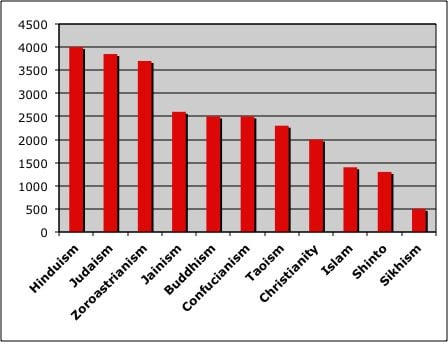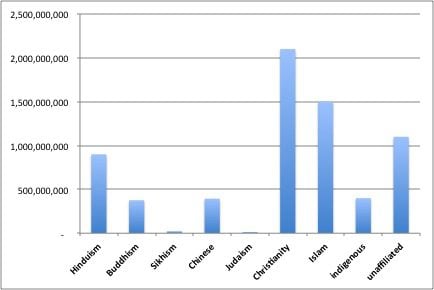In a previous series of blog entries, I addressed a common basic question: How MANY religions are there?
In my immediately preceding blog entries, I addressed a followup question: How BIG are the religions?
In this blog entry, I’d like to round out this preliminary overview of the global religious landscape by addressing another followup question: How OLD are the religions?
For the major world religions, the simple answer is: pretty old. Most of them are 2000+ years old.
This bar graph presents the relative ages (in years) of each of the major world faiths. Hinduism is the oldest, with roots stretching back some 4000 years, or more; Sikhism is the youngest, being only about 500 years old.
As the chart indicates, among the very oldest religions are Hinduism, Judaism, and (possibly) Zoroastrianism. The roots of Hinduism stretch back at least to India’s Vedic era, and perhaps even further back, into pre-Vedic times (2000 BC, or earlier). The roots of Judaism stretch back to the time of the patriarch Abraham, traditionally dated at around 1800 BC. The precise age of Zoroastrianism, the religion of ancient Persia, remains a matter of some controversy; conflicting dates suggested for the era of its founding prophet Zoroaster range from the 18th to the 6th centuries BC.
A number of major religions seem to have all gotten their start, in different places around the globe, at roughly the same time: the 6th century BC. Jainism, Buddhism, Confucianism, and possibly Zoroastrianism (if one favors a later rather than an earlier date for Zoroaster) were each born in that religiously creative century. The Tao Te Ching, the foundational text of Taoism, is also traditionally attributed to a 6th-century-BC sage known as Lao Tzu, but more recently scholars have suggested a somewhat later date for its composition.
Christianity, of course, is right at about 2000 years old, having gotten started with the life and teachings of Jesus of Nazareth (and his apostles, such as Paul) during the 1st century AD. Indeed, our Western (Gregorian, Christian) calendar revolves around the presumed date of the birth of Christ as the axis point which divides all of time and history into two eras, referred to as B.C. (“Before Christ”) and A.D. (Anno Domini, Latin for “In the Year of the Lord”).
As religions go, then, Christianity (at only 2000 years of age) is one of the younger ones. And Islam is even younger still (by about 600 years). Although Muslims point out that the Arabic term islam merely means “submission” to the will of God, and further holds that Adam, Noah, Abraham, and Moses were among the first such “submitters,” Islam as a distinctive religious movement did not appear on the scene until the prophet Muhammad established it in Arabia in the 7th century AD, making Islam in this sense some 1400 years old.
The precise origin of Shinto, the indigenous traditional religion of Japan, is a bit hazy to date with precision; many place its origins at somewhere roughly around perhaps the 8th century AD (or at least that is when written records pertaining to Shinto beliefs and practices first appeared in Japan).
Sikhism, the youngest of the world’s major faiths, was founded in India by Guru Nanak right around 1500 AD.
So, that’s it, at least as far as the major religions are concerned. But what about some of the other, perhaps smaller but nevertheless well-known religions — religions such as Baha’i, Christian Science, Mormonism, Rastafarianism, Scientology, Wicca, or the Unification Church? How old are they?
For them, the simple answer is: not very old. All of those aforementioned faiths are not only far smaller than the major faiths, but also far younger, each of them having been born as recently as the 19th or 20th centuries.
Baha’i was founded by Baha’u’llah in Persia in the mid- to late 1800s. Christian Science was founded in Boston by Mary Baker Eddy in the late 1800s. Mormonism was founded by Joseph Smith in western New York in the early 1800s. Rastafarianism was founded in Jamaica around 1930. Scientology was founded by L. Ron Hubbard in New Jersey in 1953. Wicca is a modern revival or reconstruction of ancient European forms of indigenous paganism, whose varying traditions began to emerge in Britain in the early to mid-1900s. And the Unification Church was founded in South Korea by Sun Myung Moon in 1954.
Most of today’s well-known “alternative” religions are of far more recent vintage than the larger, longer-established faiths — which count their own ages in terms of many centuries, even millennia, rather than in mere decades (or at most a couple of centuries).
However, it is perhaps also wise to remember that even the largest and longest-enduring major religions of today must have also started out at one time as small, young “minority religions” themselves, during their own early formative eras.


